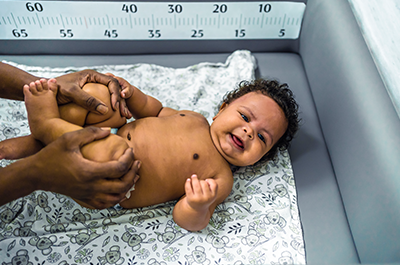Keeping children securely buckled into a car seat is so important. Babies have weak neck muscles and even school-aged children aren’t big enough to properly fit into a regular seat.
“Kids shouldn’t sit in a regular seat until they’re at least 11 or 12 years old,” says Shoshana Gordon, D.O., a pediatrician at Henry Ford Health. “My grandmother used to tell me about how kids were put on mattresses in the back of a car—we’re a far cry from that now. With more studies and research, adjustments to safety regulations are routinely made to keep kids as safe as possible.”
Here, Dr. Gordon shares how to keep your kids safe in the car during every stage of childhood. (Note: these ages are approximations, as children grow at different rates and the car seat they use is dependent upon their height and weight.)
Newborn – 3 Years Old: Rear-Facing Car Seat
From birth until about 2 or 3 years old, children should sit in a rear-facing car seat. (Or until they’ve outgrown the height and weight requirement of the car seat, as different car seats have different weight and height requirements.)
“If you’re facing forward during a collision, your chest and stomach will receive most of the impact,” says Dr. Gordon. “Your head goes forward and your neck could be injured—especially little ones who don’t have neck control. Rear-facing car seats position babies so that, in the event of a collision, the bony structures on the back are impacted and not the soft-tissue structures.”

3 Years Old – 7 Years Old: Forward-Facing Car Seat
When your child is about 2 or 3 years old until they’re about 5 to 7 years old—when they exceed the height and weight requirement of the car seat—they can sit in a forward-facing car seat with a five-point harness.
“You can get a convertible car seat for your child that transitions from rear- to forward-facing so you don’t have to keep buying a new car seat,” says Dr. Gordon. “And these car seats grow with the child.”
7 Years Old – 12 Years Old: Booster Seat
When your child has grown out of their car seat (often around age 5 to 7), they can graduate to a booster seat. Booster seats allow kids to sit up high enough so that the car seatbelt fits well. The top strap should snugly cross over their shoulder—not ride up their neck—and the lower strap should cross over their lap.
“Aside from size, another factor to consider before switching to a booster seat is whether your child is developmentally able to sit,” says Dr. Gordon. “If they’re still moving around, they should continue to use a forward-facing car seat with a five-point harness. They might need a bigger car seat to accommodate them.”12 Years Old – 13 Years Old: Back Seat
Your child should use a booster seat until they’re about 4 feet 9 inches—usually around age 11 or 12. “That’s the height where a seatbelt can fit safely around the shoulders and lap,” says Dr. Gordon.
That said, seats can be different sizes: For example, bucket seats can be bigger than bench seats, so it’s important to ensure your child fits into every seat before transitioning out of a booster seat. They should be able to sit all the way at the back of the seat with their feet flat on the ground. Your child should sit only in the backseat—not in the front seat—until they’re at least 13 years old.
Tips To Securing Your Child In Their Car Seat
It can be tricky to know whether you’ve correctly installed the car seat, especially if you’re a first-time parent. Luckily, you can take your car to an inspection station to make sure it’s secured properly—or you can have one of their certified technicians install it for you, free of charge. The National Highway Traffic Safety Administration has a directory of inspection sites where you can enter your zip code to find one near you. Sometimes it’s at your local fire department, says Dr. Gordon. Just make sure there is a certified technician on staff.
She shares a few additional car seat safety tips:

Need a pediatrician?
- The middle back seat is the safest place to put the car seat, but if you have to put it on a side of the car, either side in the back is equally safe.
- To ensure your child is secure in the car seat, do the pinch test: After buckling them in, use your thumb and index finger to try to pinch the straps together. If you can pinch them together, tighten them until you can’t. The straps shouldn’t be loose.
- Take off any bulky clothing (i.e. winter coats) before putting your child into a car seat. “Bulky clothing will prevent them from being securely strapped in,” says Dr. Gordon. “You can buy winter covers for newborns that sit on top of the car seat to keep them warm.”
- Lastly, while it might sound obvious, don’t forget to take your child out of the car seat when you’ve arrived at your destination. It’s happened enough times that some cars now have automatic alerts to remind you to check the backseat before leaving the car.
Reviewed by Shoshana Gordon, D.O., a pediatrician at Henry Ford Health who sees patients at Henry Ford Medical Center—Royal Oak and Henry Ford Medical Center—Sterling Heights.



